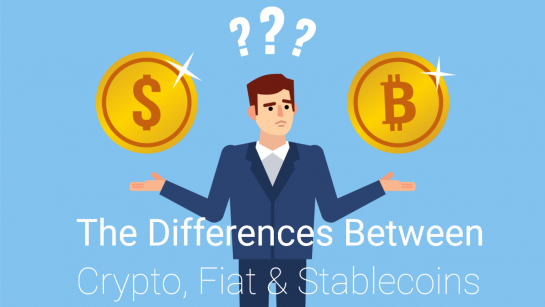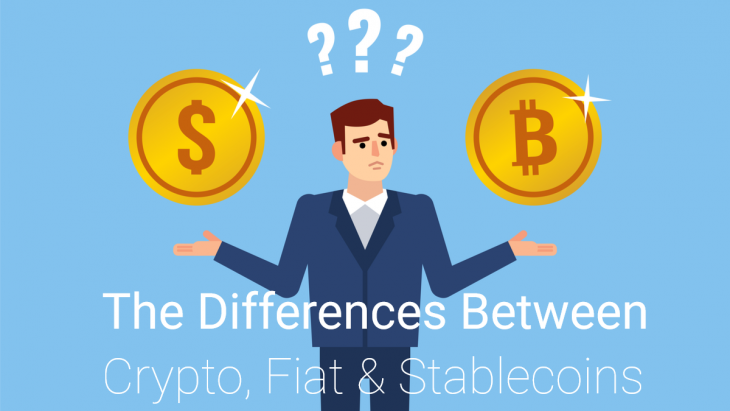Remember the days when money was just, well, money? You didn’t have to think twice about whether it was a digital asset, traditional currency, or cryptocurrency.
These days, money is evolving at an unprecedented rate. Every day it seems there’s a new breakthrough in not only how we transact, but also how we represent value in the first place.
Satoshi Nakamoto’s invention of Bitcoin and blockchain along with it upended everything about money, leaving us with the three distinct categories we have today: cryptocurrency, fiat, and stablecoins.
What is the difference between cryptocurrency and fiat? Moreover, what are stablecoins anyhow? Let’s take a quick jaunt to sort out the differences between the three.
Fiat Currency
Fiat currency is central-bank issued government money. Put another way, fiat is money used within the borders of one country and exchanged with others.
Examples of fiat currency include the US dollar, euro, yen, yuan, ruble, zar, etc. These are physical forms of money with (as of yet) no digital equivalent which the jingle of coins in your pocket serves to remind you.
- Fiat money is centralized currency, which means its monetary policy, including issuance, is government controlled by an entity such as the American Federal Reserve. The centralized nature of fiat makes it easily manipulated given the influences of special interests, human fallacy, and monetary policies driven by geopolitical ambitions.
As such, the average lifespan of a fiat currency is 27 years—far shorter than most people who have grown up with cash would expect.
Cryptocurrency
Blockchains are decentralized networks with no owner, bank, or government pulling the strings. Instead, a vast number of participants validate the network by majority-approving transactions.
Running on top of blockchains are cryptocurrencies. These digital assets can always be transacted, but while some, like Bitcoin and Litecoin, are explicitly used as money, others, such as Ethereum, have practical uses for the blockchains too.
So, cryptocurrency is money — but it also isn’t money. It just depends on which cryptocurrency you’re looking at. To illustrate this point:
A cryptocurrency such as Bitcoin is always money, Ethereum is sometimes money, and Binance Coin is a utility token.
With that distinction out of the way, the next important quality of cryptocurrencies comes into view.
Cryptocurrencies are digital, global, and have no physical analog. This makes it possible for anyone, anywhere to use them with nothing more than a smartphone and internet connection.
Stablecoins
At the end of the day, stablecoins and cryptocurrency are one in the same.
The major difference between them is:
- Stablecoins are cryptocurrencies that are backed by other assets like U.S. dollars, euros, and gold—all for the purpose of giving them stable value and reducing volatility.
Apart from giving stablecoins stable value, the asset-backing digitizes the stable asset so that it can be digitally traded around the world.
When a stablecoin’s value is pegged to USD on a 1:1 basis, it means that there is $1 in a reserve for every corresponding stablecoin. In theory, stablecoins are only issued when there is an asset in reserve to back them. Kind of like when fiat was backed by the gold standard.
Comparing Cryptocurrency to Fiat Money
How do cryptocurrencies like Bitcoin, Ethereum, and stablecoins compare to fiat currencies such as USD, EUR, YEN, and AUD?
The major differences between cryptocurrencies and fiat currencies are:
Cryptocurrencies
- Digital
- Decentralized
- Global
Fiat Currencies
- Physical
- Centralized
- National
When wondering how cryptocurrencies compare to fiat currency, what is readily apparent is how well-suited cryptocurrencies are for today’s fast-paced, global, online economy.
Fiat currencies, in contrast, have uses within national boundaries, but their inefficiencies rise to the top once exchange rates, cross-border settlements, and banks get involved.
A strength favoring fiat money, however, is that the centralized payment railways transacting them, such as PayPal and Visa, are fully-integrated the world over and deliver mind-boggling transaction speeds.
Additionally, many countries are warming to the idea of going digital, with China furthest along in its plans for a digital yuan. Facebook’s Libra global currency brought the importance of going digital front and center for regulators who are keen to stay ahead of private corporations.
With the race to create global value, utility, and commerce heating up between cryptocurrencies and fiat money, expect to witness many incoming developments in the way you pay.









